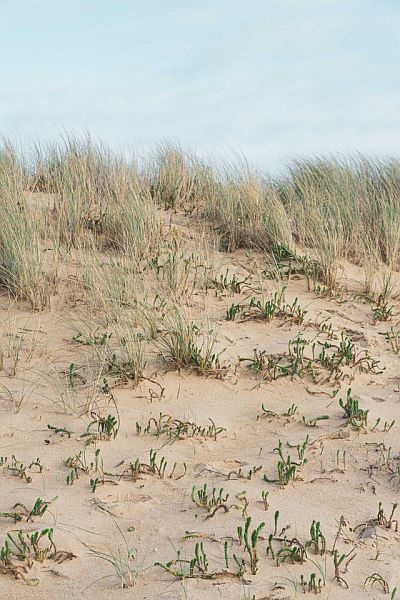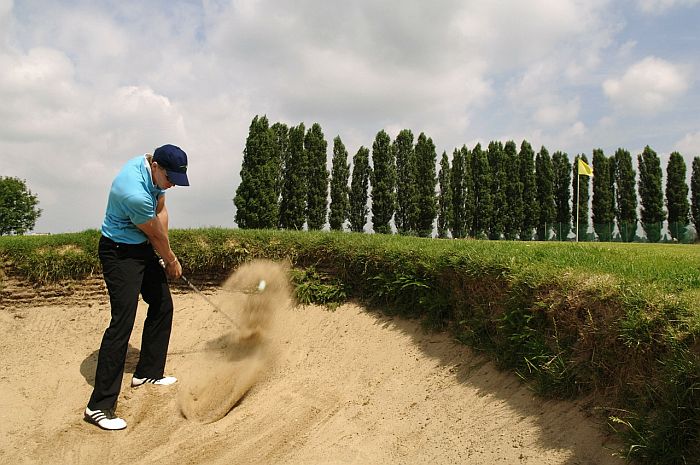You can put sand on grass to level and fill low and exposed areas of your lawn. Sand can also be used to cover surface-level tree roots and control thatch build-up. The practice of putting sand on grass is commonly referred to as top dressing.
Every gardener’s dream is to have a healthy, luscious lawn that thrives throughout the year. When your lawn develops issues like bare and uneven spots, it can be quite unsightly and will definitely ruin the aesthetics of your garden. One of the most common solutions to restoring the health of your lawn is to top-dress, which is the process of putting sand on it.
Putting sand on grass is a heavily debated topic because it’s often known as a practice that can do more harm than good. While this is true to an extent, it can be beneficial in certain circumstances. This can include covering tree roots, leveling low spots and evening out patches of lawn that are uneven.
So, why put sand on grass? Keep reading to find out more about what sand does for grass and why it can be really useful in gardening maintenance, specifically lawn care.
What Does Sand Do For Grass?

While sand doesn’t have many nutritional benefits when used to top-dress, there are a number of aesthetically pleasing advantages in using sand on grass. In fact, this is a practice that was initially introduced on golf courses and has made its way to residential lawns, thanks to its great perks!
The type of grass you have in your garden makes all the difference. You might be having issues with bare or uneven spots on your lawn because the grass isn’t compatible with your climate conditions.
It’s worth digging into the types of grass best suited for your region before using sand on grass, as it will be futile if your grass just isn’t meant for your climate. This will save you both time and money. Bermuda grass and Zenith Zoysia grass are some of the best options for the climate in Florida.
For Covering Bare, Exposed And Uneven Patches Of Lawn
The practice of topdressing has taken off, mainly due to its widespread use in covering bare or exposed patches in lawns. While top dressing may sound like a pretty easy practice, there are a couple of points to note to do it correctly and to prevent worsening the condition of your lawn.
Top Dressing Pointers
- Your lawn should be dry — ideally, for a few days.
- Make sure that the sand you’re using to top-dress is free of weeds and nematodes.
- Try to get sterilized sand, if possible.
- The sand that you’re using should be the same type and texture as the soil beneath the patch of lawn you’re treating.
- A heavy hand isn’t going to cut it – go easy on the sand. You should put no more than 1 cm of sand over the area and the tips of the grass should still be exposed.
- If you plan on using compost or soil mix to top dress, aerating the lawn before top dressing will allow for added benefits, such as allowing the nutrients to go deep into the soil.
- Don’t cut your grass for roughly 3-4 days after top dressing.
- Reduce foot traffic and refrain from placing any heavy objects over the treated area for a while.
YouTube user Connor Ward provides a detailed explanation of how he uses sand on grass in this video:
How To Use Sand To Top Dress Your Lawn
When top dressing, there are a couple of tools you should have on hand to make the process a lot easier. The main tools are rakes, shovels and wheelbarrows.
Step By Step Top Dressing Process

- Mow your grass, preferably with a catcher attachment.
- Drop little piles of sand onto different parts of your lawn using a shovel.
- Rake over the sand piles to level it over the bare or uneven area. Make sure to rake over the little clumps too.
- Water your lawn.
If your main issue is an uneven lawn, you can watch this video about how to even out your lawn using sand by YouTube user Ryan Knorr Lawn Care:
Is It Better To Put Soil Mix Rather Than Sand On Your Grass?
Using a good-quality soil mix to top-dress your lawn may be a safer bet than sand. The main factor for choosing soil mix instead is its nutrient density. Soil mix is extremely beneficial to your lawn, as well as the soil beneath your lawn, for several reasons:
- It contains a rich mix of nutrients
- It maintains its nutrient density over a long period of time
- It’s affordable
- It’s great for improving drainage
- It reduces the likelihood of erosion
- It reduces the need for you to use pesticides and chemicals
- It builds up good bacteria
- It helps reduce thatch build-up
I think it’s safe to say that going with a good-quality soil mix is both safer and better for your lawn’s health.
What’s So Controversial About Putting Sand On Grass?

The big debate about using sand on grass is due to the fact that this process could be detrimental to your lawn if it’s not done properly. The hype about putting sand on grass comes from its use in high-activity areas, such as golf courses.
It is important to remember that golf courses are known as “commercial lawns” and cannot be treated the same way as residential lawns. Golf courses are quite literally built on sand, which is why sand is so compatible. The opposite can be true for domestic lawns.
One of the main arguments about using sand on grass rests on the fact that sand has very poor nutritional value and it’s also unable to retain any nutrients. If you put sand on grass often (for example, every month), it can result in the grass losing its fertility.
Once your grass loses its fertility, it can be quite difficult to restore. Prevention is better than cure!
Putting sand on grass regularly is a major no-no. You should ideally only do it once a year, and only if you really need to. Regular use of sand on grass can result in really bad drainage issues and dry pockets in the soil.
Using sand to top-dress should not, in my opinion, be used for any other reason other than to cover up or even out your lawn. Using it for greater issues such as to improve drainage is definitely not a good idea. As with any garden practice, it is important to weigh the pros and cons to figure out whether this is something your garden needs to flourish.
FAQs
Is it good to put sand on your lawn?
It is good to put sand on your lawn if you follow the correct process. You can put sand on your lawn to cover bare areas and tree roots. Putting sand on your lawn can be risky, but when done correctly, it can prove to be a very beneficial process.
When should I put sand on my lawn?
You should put sand on your lawn if you need to cover bare, exposed and uneven patches. Sand will also help to cover surface tree roots and fix heavy thatch build-up.
Does lawn sand help drainage?
Lawn sand does help drainage. A key factor to consider when using sand to improve drainage is whether the type of sand you’re using is compatible with the sand you have in your garden. Sand particles will break up soil clods, increasing draining and helping to aerate the soil.
What type of sand is best for lawns?
Sharp sand is best for lawns that are sandy or loamy. It’s an affordable option to consider and is known as an all-rounder due to its versatility. It can be used for a number of garden tasks, including laying slabs and block paving.
Can I put builders sand on my lawn?
You can’t put builders sand on your lawn because it has a high pH content and is usually quite salty, which could prove to be harmful to your lawn. One of the main risks of using builders sand is poor drainage.
How fast does lawn sand work?
How fast lawn sand works depends on what you’re using it for. You can see results between a couple of days to 2 weeks if you’re using it to top dress your lawn. A key factor that determines how fast it works is whether your lawn has been watered sufficiently.
Lawn Sand – Rounding Up
Why put sand on grass? Putting sand on grass is a good way to cover up bare, exposed or uneven lawns. I recommend that you only use sand on your grass if you really can’t get your hands on a good-quality soil mix.
Soil mix is ideal to fix any aesthetic lawn issues, as well as give the soil beneath your lawn a healthy dose of nutrients.
Please feel free to comment should you have any questions or thoughts regarding putting sand on grass. I would love to hear from you.


Hi there,
I would like to use sand in my lawn next year to smooth out the divots and unevenness of the lawn. I will not be putting more than .75″ and will only put it in once. The following year after sand I would like to put compost or screen black dirt..
My question for you, will it cost issues if I was to put a layer of sand down next spring .75″ and the same year (fall) put down screen black soil and compost combined?
I’ve heard this can cause issue due to layering the soil with different materials; please advise if this is true? I also heard that once you use sand you will have to keep going using sand as a top dressing?
Any help would be greatly appreciated